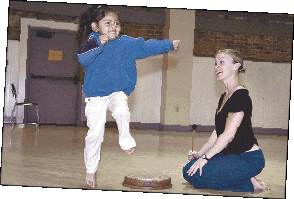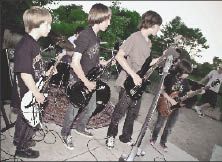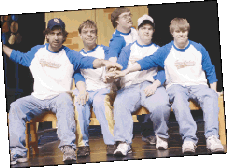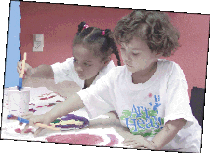The requirements of the No Child Left Behind act have resulted in arts education being cut out of public school budgets across the nation. That means children are receiving less exposure to opportunities for creative expression, especially if they’re in low-income neighborhoods or living in foster care or group home situations where the chances for extracurricular activities are few.
“Testing mandates for No Child Left Behind have limited anything other than math and language skills in a lot of schools,” says Tom DeCaigny, executive director of the Performing Arts Workshop in San Francisco. “Teachers teach to the test, but we’re starting to see acknowledgements that that model just isn’t working.”
Many private nonprofits and youth agencies are stepping into the gap, not just for the sake of arts education but also because creative expression gives at-risk youth an empowering voice. “A lot of at-risk young people want something real,” says DeCaigny. “Performing arts give them a sense of purpose and humanity, as well as tools for critical thinking and examining their own lives in relationship to the world.”
How to do the arts
Teniqua Broughton, program director with Free Arts of Arizona, says her organization’s programs are typically delivered through group sessions with several students working with one mentor artist. “We find kids are more open to activities in a group than one on one,” she says.
Ray Nelson, founder of Guitars Not Guns, has found the same thing. His program provides instruction in guitar to foster care youths through group music lessons provided by several teachers at once.
A critical component of youth development through the arts is relationship-building between students and instructors. At the Performing Arts Workshop, kids work with the same teaching artist from one week to the next, allowing them to develop a trusting relationship with an adult.
Why it works
“Some of these kids live in the system,” says Broughton of the youth Free Arts serves, many of them long-term residents of treatment centers and group homes. “It’s critical to use the arts with these kids because they need a chance for choice and expression.” Broughton says the arts give young people an outlet for their pain, rather than letting that pain define who they are. “When kids have a chance to say how they feel, it gives them a voice.”
“The performing arts are a safe place to let emotions out,” says Nicolette Stearns, co-founder of ArtStream, a Bethesda, Md.,-based organization that takes theater to underserved communities. “Theater works because it feels safe,” she adds. “It allows for distance, so it’s not like therapy. It’s more abstract, so people don’t feel forced to express themselves.”
Finding support
Stearns says it’s essential when starting performing arts programs for underserved communities to call on local arts resources for help. ArtStream has received support from the Arts and Humanities Council of Montgomery County and the Maryland State Arts Council. “Find resources in your community,” she says. “If you don’t know how to do something, go to someone who does.” Stearns and her colleagues also called on old contacts in the theater industry to help with their program and relied on local teens as volunteers. Some of those teens have come back to work for ArtStream as adults.
Recruiting people to teach performing arts to at-risk kids isn’t as tough as one might imagine. Broughton says Free Arts of Arizona has more than 700 volunteers on its roster. “Keeping them and keeping them active is harder than recruiting,” she says, noting that Free Arts is working at capacity and has a waiting list of group homes and treatment centers that want to use the organization’s services.
Nelson, with Guitars Not Guns, also has no shortage of volunteers, attracting instructors who include practiced musicians, attorneys, policemen and businesspeople who happen to know how to play the guitar and like working with kids.
Despite volunteers’ willingness, finding time to teach can be a problem, particularly if the program is run in conjunction with a school or school system. DeCaigny says organizations must work with teachers and administrators in coming up with an arts curriculum that teaches critical life skills, if they want to make use of in-school time.
“We’re in a very competitive academic environment,” he says. “Institutional time is the biggest challenge.” He says it’s also important to evaluate what you’re doing on a continuing basis. “We’ve been around 45 years, but that doesn’t mean we have this figured out,” DeCaigny says. “Make sure kids are responding to what you’re doing.”
Few of the programs conduct formal evaluations, but they rely instead on informal, anecdotal information about their success.
Deborah Huso is a freelance writer in Blue Grass, Va. dhuso@youthtoday.org.
Performing Arts Workshop
San Francisco
(415) 673-2634
http://www.performingartsworkshop.org
The Strategy: Teach at-risk youth problem-solving and creative skills through in-depth exposure to the performing arts.
Getting Started: The Performing Arts Workshop was founded in 1965 by former professional dancer and choreographer Gloria Unti after she found kids from local gangs hanging out near her Telegraph Hill studio, usually to get a glimpse of her female students. The youths inspired her to start a program specifically for them, based on using the creative process – involving dance, drama, or writing – to address and solve problems.
 |
|
Stepping up brings smiles at Performing Arts.
Photo: Teresa Kennett |
How It Works: The Performing Arts Workshop takes arts workshops to students in two forms, its Artists-in-Schools program, under which teaching artists go directly to schools with high populations of at-risk kids, and its Artists-in-Communities program, which has the instructors serve kids at community centers, in after-school programs, in juvenile halls or in juvenile residential detention centers. The programs run from 10 to 30 weeks, with workshops held weekly.
To teach critical thinking, for example, artist teachers may lead children through a theater improvisation workshop, in which they are divided into groups and must solve a problem, such as how to cross an imaginary river, in cooperation with other kids in the group. Each group then acts out its solutions to the problem and is critiqued by the others on how well the group solved the problem and what they might do better.
Youth Served: The Performing Arts Workshop serves 9,600 children annually in San Francisco and four Bay-area counties, focusing on at-risk, low-income youth and English language learners. The program works with 18 public schools, 70 child development centers, and a dozen after-school, transitional housing and juvenile detention center sites. Participants range in age from pre-kindergarten to 24 years old.
Staff: The organization has eight administrative staff members, six of them full-time, and 32 part-time teaching artists.
Money: The program operates on an annual budget of $1.2 million, with funding from the U.S. Department of Education Model Development and Dissemination for Arts in Education grant, the William and Flora Hewlett Foundation, the Walter & Elise Haas Fund and the Sidney E. Frank Foundation, as well as from the City of San Francisco.
Results: Classroom teachers and after-school staff whose students have participated in Arts Workshop programs report a 44 percent rate of positive change in social behavior among students, as well as a 22 percent positive change in independent thinking skills. Students also show a 20 percent improvement in their ability to concentrate and focus on activities. These results are based on surveys made both before and after the program.
Guitars Not Guns
 |
|
Electrifying experiences: Youths playing last July.
Photo: Jenny Cash |
Peachtree City, Ga.
(770) 861-2443
http://www.guitarsnotguns.org
The Strategy: Provide foster children with guitars and music lessons to give them an artistic outlet as well as at least one form of constancy in their lives.
Getting Started: Guitars Not Guns started 10 years ago after founders Ray and Louise Nelson (former musicians then living in San Jose, Calif.) took in four foster children. They became concerned that children in foster care are frequently moved from one home to another with few personal possessions and little consistency in their lives. The couple started collecting secondhand guitars from acquaintances in the music industry to give to foster children, and then gradually started providing music lessons. Guitars Not Guns now has 25 chapters in the United States and one in Canada.
How It Works: Guitars Not Guns recruits participants mainly through the foster care system, though they accept any child interested in participating. They partner with the Boys & Girls Club in Peachtree City and hold many of their classes there. Volunteer instructors hold music lessons once a week, usually after school or in the evenings.
Youth Served: The Peachtree City program serves about 100 children a year. Nationwide, Guitars Not Guns has reached more than 1,000 youth since the organization started. Participants range in age from 8 to 18.
Staff: Peachtree City’s Guitars Not Guns has no paid staff. Ray Nelson, as a retired musician, runs the program, and all instructors are volunteers.
Money: Nelson says his chapter runs on a budget of about $10,000 a year. Guitars Not Guns holds periodic fundraisers, and each chapter raises its own money. “We are almost self-sustaining,” says Nelson. The program also receives support from the Gibson Foundation, Freddie Mac and the United Way.
Results: Nelson says the program does not conduct any longitudinal studies on results. Most of the youths who graduate from Level I music lessons go onto Level II, and many complete the program and return to play music with new students in informal jam sessions.
 |
|
Getting their kicks: Actors from “Kickball the Musical”: Michael Dowling, Eric Niedringhaus, Frank Stephens, R.J. Martin and Mark Jones. Photo: ArtsStream
|
ArtStream
Bethesda, Md.
(301) 941-1008
http://www.art-stream.org
The Strategy: Expose underserved communities in the Washington, D.C. area to the healing power of the performing arts through participation in theater productions.
Getting Started: ArtStream was started five years ago by five artist-educator friends who wanted to take performing arts education to underserved groups, including children who would not normally have access to the theater. The group established a board of local businesspeople and obtained its nonprofit designation three years ago.
How It Works: ArtStream offers a variety of programs for both children and adults. Its youth work includes music and movement classes for children with disabilities, including autism, Down syndrome, cerebral palsy and other conditions that would normally prevent them from participating in traditional theater, as well as workshops for children defined as at-risk because of their socioeconomic status.
For example, ArtStream recently conducted a theater workshop with autistic children, getting them to act out the roles of different dogs in Go, Dog, Go! using movement accompanied by music. “A lot of the kids don’t have verbal skills, but they can focus on movement and listen to music,” ArtStream co-founder Nicolette Stearns says. ArtStream also works with the Center for Adoption Support and Education (CASE) to provide programs to adopted children who have come out of foster care and other higher risk adoption scenarios.
Youth Served: ArtStream serves about 200 children a year through its workshops and classes, with participants ranging from pre-school to young adult, including those with severe physical and mental disabilities and those in at-risk social or economic situations.
Staff: The organization has five paid staff members and about 25 volunteers, many of them teens and college students. The group also hires about 20 contractors to teach classes and to do costume and set design.
Money: ArtStream operates on an annual budget of $250,000 and works out of office space donated by the Jim and Carol Trawick Foundation.
Results: ArtStream does not conduct formal evaluations. “Our evidence of success is mainly anecdotal,” Stearns says. “Parents have seen verbal skills and confidence increase.” Stearns says she measures ArtStream’s effectiveness in large part by the number of students who return to participate in additional programs, as well as by the number of support organizations, hospitals and schools that seek out healing arts services.
 |
|
Brushing up on painting skills.
Photo: Free Arts |
Free Arts of Arizona
Phoenix
(602) 258-8100
http://www.freeartsaz.org
The Strategy: Provide mentoring to homeless, neglected and abused children in group homes, shelters and residential treatment centers through regular interaction with and instruction from visual and performing artist teachers.
Getting Started: Free Arts of Arizona was started 16 years ago by arts therapist Margaret Beresford, as the second location of Free Arts, which was first established in Malibu, Calif. The Arizona program started with five volunteers who provided arts education to about 60 children.
How It Works: Free Arts of Arizona offers four separate programs to severely at-risk children: a weekly mentor program, one-day arts festivals, professional artist series and multicultural arts camps. The weekly mentor program is the core of Free Arts of Arizona and involves mentor artists who work weekly with 10 children for eight to 16 weeks, assisting them with arts projects on site at their group home, shelter or residential treatment center. Participating youths learn skills in the visual or performing arts, including knitting, drawing, Latin dance and drumming. Children interested in a specific art form can participate in the Professional Artist Series, which involves a mentor artist teaching his or her specialty craft or skill. Children see the same mentor artist or artists each week for the length of the programs.
Youth Served: Over 6,100 children, ages 3 to 21, are served annually at 114 sites around Maricopa County (Phoenix).
Staff: Free Arts of Arizona has 11 full-time staff members, two part-time employees, and 792 volunteers. Almost all mentoring artists are volunteers, though those in the Professional Artist Series generally are paid a stipend.
Money: The organization has an annual operating budget of $1.1 million, most of which comes from individual donations. Other funders include Valley of the Sun United Way, IKEA, Paradise Bakery, APS, American Express and Arizona Commission on the Arts, Arizona Department of Public Safety Victims of Crime Act and the Governor’s Office for Children, Youth and Families grants.
Results: In a survey concerning 142 participating children last quarter, 11 facilities staff members reported moderate to substantial improvement in everyday coping skills in 100 percent of those children.





























